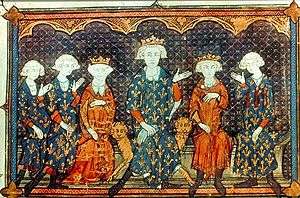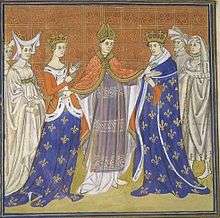Blanche of Burgundy
| Blanche of Burgundy | |
|---|---|
 | |
| Queen consort of France and Navarre | |
| Tenure | 3 January - 19 May 1322 |
| Born | c. 1296 |
| Died | c. 1326 (aged 29–30) |
| Spouse | Charles IV of France |
| Issue |
Philip of France Joan of France |
| House | House of Ivrea |
| Father | Otto IV, Count of Burgundy |
| Mother | Mahaut, Countess of Artois |
| Religion | Roman Catholicism |
Blanche of Burgundy (c. 1296 – c. 1326) was Queen of France and Navarre for a few months in 1322 through her marriage to King Charles IV the Fair. The daughter of Count Otto IV of Burgundy and Countess Mahaut of Artois, she was led to a disastrous marriage by her mother's ambition. Eight years before her husband's accession to the thrones, Blanche was arrested and found guilty of adultery with a Norman knight. Her sister-in-law, Margaret of Burgundy, suffered the same fate, while her sister Joan was acquitted. Blanche was imprisoned until she became queen, when she was moved to the coast of Normandy. The date and place of her death are unknown; the mere fact that she died was simply mentioned on the occasion of her husband's third marriage in April 1326.
Early life
Blanche was the younger daughter of Otto IV, Count of Burgundy, and Mahaut, Countess of Artois. Her father died in 1302, leaving the county to Blanche's younger brother, Count Robert.[1] Blanche's elder sister Joan was supposed to marry King Louis the Headstrong of Navarre, the eldest son and heir apparent of King Philip the Fair of France, but Philip the Fair changed his mind and arranged for her to marry his second son, Count Philip the Tall of Poitiers, in 1307. The same year, Louis married Margaret of Burgundy.[2][3] The Countess of Artois was proud of this achievement and quickly started negotiating her younger daughter's marriage to Count Charles the Fair of la Marche, King Philip's third son, offering a huge dowry. The negotiations were successful and on 23 September 1307, the eleven-year-old Blanche and two years older Charles concluded a marriage contract.[3] The marriage ceremony was hastily performed at Countess Mahaut's castle in Hesdin in January 1308.[1] At first, the Count and Countess of la Marche had an unremarkable marriage that was neither as flawed as that of the King and Queen of Navarre nor as harmonious as that of the Count and Countess of Poitiers.[3]
Adultery accusations

In 1313, the Countess of la Marche's sister-in-law and brother-in-law, Queen Isabella and King Edward II of England, paid a visit to King Philip. Isabella presented her brothers and sisters-in-law with embroidered coin purses. Later that year, upon their return to London, Isabella and Edward held a banquet during which the Queen noticed that the coin purses she had given to Blanche and Margaret were now in the possession of the Norman knights Gautier and Philippe d'Aunay. From that she concluded that the brothers were having relationships with her sisters-in-law. When she visited Paris again in 1314, she informed King Philip about her suspicions.[4]
Blanche and Margaret were soon accused of inappropriate conduct, such as drinking and eating with the knights, and of eventually committing adultery with them in Paris guard tower known as the Tour de Nesle. Blanche's sister Joan was accused of hiding the affair and later of participating in it.
The accusations against Countess Blanche and Queen Margaret were more than likely true, but several 14th-century chroniclers believed that their father-in-law's popularly despised chamberlain Enguerrand de Marigny might have falsely incriminated them and the knights.[4]
Trial and imprisonment
.jpg)
After a certain period of time, King Philip ordered the arrest of all his daughters-in-law and the knights.[4] Following torture, the knights confessed to adultery[5] and admitted that it had lasted three years.[6] The Countess of la Marche and the Queen of Navarre were tried before the Paris Parlement and were found guilty of adultery. Their heads were shaven and both were sentenced to life imprisonment underground in Château Gaillard, while their lovers were condemned to death and duly executed.[4] Her first child, a son named Philip, was born around 5 January 1314 and thus before the accusation of adultery levelled at his mother, so presumably his paternity was not challenged; her second child, a daughter named Joan, was born in 1315 after the trial, so some doubt about her paternity was suggested by the contemporary Continuatio of the Chronicle of Guillaume de Nangis, moreover because reportedly Blanche became pregnant either by one of her jailers or by her own husband ("a serviente quodam eius custodiæ deputato dicebatur...a proprio [comite] diceretur");[1][7] however, she was presumably accepted as part of the royal family according to later sources.[8] Despite her disgrace, Blanche remained in contact with her ambitious mother and often received gifts from her.[9]
King Philip, severely shocked by the scandal, died within a year. Margaret, now queen of France, died imprisoned soon thereafter, probably murdered. Louis's reign was cut short by his sudden death. Soon, Philip the Tall and Blanche's sister Joan became king and queen of France and Navarre. It was suggested that Blanche was treated better once her sister became queen, but that was concluded from a single misinterpreted document and may not be entirely accurate.[9] Queen Joan did, however, arrange for her youngest daughter Blanche to become a nun, hoping that the seven-year-old's cloistered life would atone for her sister's transgression.[10]
Queenship and death

On Philip the Tall's death on 3 January 1322, Blanche's husband inherited the crowns. Blanche thus became queen of France and Navarre, but her husband still refused to release her.[11] Both of her children died in infancy, Philip before 24 March 1322 and Joan on 17 May 1321.[1] Charles requested annulment of their marriage, to which Blanche reluctantly agreed. The annulment was justified by the claim that Blanche's mother was Charles's godmother, although probably the real reason was Blanche's pregnancy during her imprisonment.[7] Pope John XXII declared their marriage null and void on 19 May 1322,[1] and gave both Charles and Blanche permission to remarry.[9] The Countess of Artois requested, among other things, the return of her daughter's enormous dowry.[3]
Though she was replaced immediately by Marie of Luxembourg, there was no hope for Blanche to remarry, as she was sent to Gavray Castle. There is no evidence that supports the common belief that she died as a nun at Maubuisson Abbey.[9] Having spent eight years imprisoned underground, the former queen suffered from poor health.[4] The date of her eventual death is unknown; the Pope mentioned her as dead in a document of 5 April 1326 issuing a dispensation for the marriage of her former husband and Jeanne d'Évreux.[9]
In fiction
Blanche is a character in Les Rois maudits (The Accursed Kings), a series of French historical novels by Maurice Druon. She was portrayed by Catherine Hubeau in the 1972 French miniseries adaptation of the series, and by Anne Malraux in the 2005 adaptation.[12][13]
Family tree
| Philip the Fair | Otto | Mahaut | |||||||||||||||||||||||||||||||||||||||||||||||||||||||||||||||
| Isabella | Margaret | Louis the Headstrong | Philip the Tall | Joan | Charles the Fair | Blanche | |||||||||||||||||||||||||||||||||||||||||||||||||||||||||||
References
- 1 2 3 4 5 Doss-Quinby, Eglal; Krueger, Roberta L.; Burns, E. Jane (2007). Cultural Performances in Medieval France: Essays in Honor of Nancy Freeman Regalado. DS Brewer. ISBN 1843841126.
- ↑ Wagner, John (2006). Encyclopedia of the Hundred Years War. Greenwood Press.
- 1 2 3 4 Wei, Ian P. (2000). Medieval Futures: Attitudes to the Future in the Middle Ages. Boydell & Brewer. ISBN 0851157793.
- 1 2 3 4 5 Weir, Alison (2012). Isabella: She-Wolf of France, Queen of England. Vintage Books. ISBN 0099578395.
- ↑ Broad, Jacqueline; Green, Karen (2010). Virtue, Liberty, and Toleration: Political Ideas of European Women, 1400-1800. Springer. ISBN 9048174708.
- ↑ Bradbury, Jim (2007). The Capetians: The History of a Dynasty. Continuum International Publishing Group. ISBN 0826435149.
- 1 2 Recueil des Historiens des Gaules et de la France vol. XX: Continuatio Chronici Guillelmi de Nangiaco, pp. 609 and 613.
- ↑ Père Anselme notes that “un rouleau de la Chambre des Comptes à Paris” confirms Joan's death “le jour de la Pentecôte 17 May 1321” and her burial at Maubuisson Abbey. A document dated 6 Jul 1324 records a payment made to “Domicella Maria de montibus quondam nutrix defunctæ Joannnæ filiæ regis” by “idem rex eidem...dum erat comes Marchæ”. Père Anselme: Histoire généalogique et chronologique de la maison royale de France, vol. I, p. 96.
- 1 2 3 4 5 Allen Smith, Katherine; Wells, Sctt (2009). Negotiating Community and Difference in Medieval Europe: Gender, Power, Patronage, and the Authority of Religion in Latin Christendom. Brill. ISBN 9004171258.
- ↑ Brown, Elizabeth A. R. (1978). The Monarchy of Capetian France and Royal Ceremonial. Variorum. ISBN 0860782794.
- ↑ Williams, Marty; Echols, Anne (1992). An Annotated Index of Medieval Women. M. Wiener Pub. ISBN 0910129274.
- ↑ "Official website: Les Rois maudits (2005 miniseries)" (in French). 2005. Archived from the original on 15 August 2009. Retrieved 25 July 2015.
- ↑ "Les Rois maudits: Casting de la saison 1" (in French). AlloCiné. 2005. Archived from the original on 19 December 2014. Retrieved 25 July 2015.
External links
| Royal titles | ||
|---|---|---|
| Preceded by Joan II of Burgundy |
Queen consort of France and Navarre 1322 |
Vacant Title next held by Marie of Luxembourg |